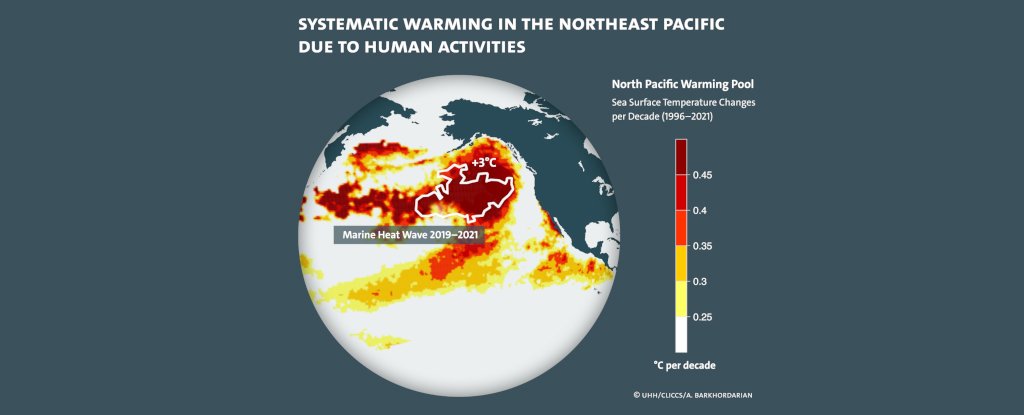Products You May Like
Like its movie namesake, the horrific marine heatwave nicknamed the Blob destroyed much in its path during its peak, causing mass deaths of fish, birds, and many other marine animals, threatening fishing industries.
Since then, the Blob has at least briefly reared its head twice, hinting at an underlying persistence to its cause.
Now, researchers have identified the systematic warming in the Pacific Ocean that fueled the Blob’s rise, and their modeling confirms that – as previously suspected – it is not the result of natural climatic variation.
“Discovery of the long-term warming pool will now provide us with crucial information on the likelihood of such extreme events in the future,” says Universität Hamburg atmospheric scientist Armineh Barkhordarian.
Barkhordarian and colleagues detected a persistent pool of warmed water in the Northeast Pacific with increased annual mean temperatures of around 0.4 °C per decade. Summer water temperatures now linger for 37 days longer than 20 years ago.
The team also discovered a decline in low clouds – which usually have a cooling effect on the waters below – over this region during the cold season. This strengthens the atmospheric high-pressure systems above the warm water pool during winters.
Using multiple models, the team calculated that there is a less than a 5 percent chance this high-pressure system has been unusually strengthened during winter because of natural variation.
Their modeling also revealed a less than 1 percent chance the Blob could have formed in 2019 without all the excess greenhouse gasses humans have pumped into our atmosphere. Temperatures reached up to 6 °C above average during this marine heatwave.
These findings are backed by previous research that found marine heatwaves like the Blob are 20 times more likely now because of human-induced climate change.
“This warming pool will continue to increase the water temperature in the future, increasing both the frequency and intensity of local marine heatwaves. The sharp increase in average water temperature is pushing ecosystems to their limits,” explains Barkhordarian.
The suffocating, hot blob of water that began in 2013 decimated marine life, killing more than 100 million Pacific cod, thousands of seabirds, and other animals not even accounted for. It also fueled massive toxic algal blooms that shut down fishing industries and may have contributed to a 75 percent decline in whale mother-calf encounters.
The mysterious sea star wasting syndrome also just happened to start nearby at the same time as the appearance of that first Blob.
What’s more, these marine heatwaves are by no means confined to the north Pacific. Similar rapid ocean warming events are causing havoc on fisheries and ecosystems from the Atlantic to southern seas.
Beyond their immediate impacts on wildlife, marine heatwaves can also contribute to severe droughts on nearby land.
“More frequent and extreme marine heatwaves are a serious burden for affected ecosystems, ” warns Barkhordarian. “This not only poses a tremendous threat to biodiversity; it can also push these marine ecosystems past a tipping point, after which they can no longer recover.”
We still have the power to reduce the impact and severity of these marine heatwaves, and many people around the world, from researchers to activists are fighting to do so.
This research was published in Communications Earth & Environment.
